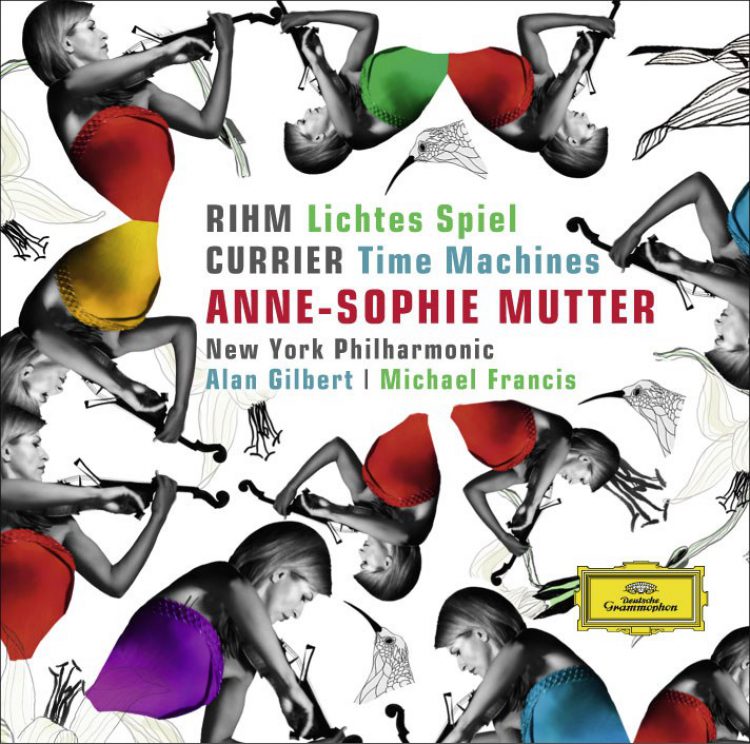
She also enjoys returning to musicians she knows. “In the life of a soloist there’s more than just one facet. After premiering a concerto, I generally want a chamber work. This was the case with Krzysztof Penderecki’s Metamorphosen and would also have been the case with Witold Lutosławski if he hadn’t died first.” Wolfgang Rihm’s violin concerto from 1991, Gesungene Zeit, was initially followed by a second orchestral work, Lichtes Spiel, which received its first performance in New York in 2010. But this last-named work was followed almost at once by a piece of chamber music: Dyade. The differences between the two orchestral works are clear for all to hear and see. For Lichtes Spiel, Anne-Sophie Mutter wanted a Mozart orchestra.
“For years I’ve been conducting Mozart’s concertos from the violin. I wanted to compare and contrast these wonderful pieces with an alternative work that would be similarly orchestrated but which would contain new markings for the violin.”
She had hoped that the resultant restrictions would inspire her, and in this she was to be proved right. “The decision to forgo a vast body of percussion instruments and an elaborate brass department leads necessarily to a greater concentration on the innermost quality of the principal instrument, which is the violin’s singing tone.” This singing tone is central to Rihm’s work, which is subtitled “A Summer Piece”. For Anne-Sophie Mutter, the “light game” conjures up associations of a summer night, a midsummer night’s dream, while the flashing accents of the score recall Shakespeare’s will-o’-the-wisps. “Time and again the flickering lights illuminate an almost romantic in-between state. Perhaps this is where the idea for Lichtes Spieloriginates. I find these flickering accents typical of Rihm’s work in general – they were already present in Gesungene Zeit. The manner in which an emotion suddenly flares up and an interval abruptly comes to the forefront of our attention, only for it to withdraw again, is characteristic of Rihm’s musical language in Dyade, too.”
In Lichtes Spiel, the theme that is revealed in the very first bars returns in the form of a development section and a series of recapitulations that are laid out along almost classical lines, with the result that the theme is ever-present. By contrast, the rhapsodic Dyade remains in a state of endlessly flowing motion. There are no rests in the score. In a letter to the violinist, Rihm describes Dyade as a “two-way relationship, with all that that involves”. The work eschews the sort of dialogue normally associated with a concert piece, preferring in its place what might be described as a single voice structured in the form of a dialogue. The music has something immediately graspable and comprehensible to it. If Rihm speaks of “the relationship between a couple” and of the “result of a coming together of two separate entities”, then this makes immediate sense. “Earnestness and sweetness are inextricably interwoven”, Rihm goes on. “The whole thing is an organic, flowing, developing structure that sounds as if it had just been improvised. You will inevitably be familiar with this idea of growth from the works of George Enescu. Organic growth, born entirely from the musical line.”

This intense and lyrical conversation that two people conduct with a single voice is a microcosm of miniature thoughts and ideas, not a musical dialogue in which a theme is expounded and taken up by the other instrument. Conversely, this classical approach is pursued by Krzysztof Penderecki in his Duo concertante, in which violin and double bass take turns to speak, one of the partners falling silent whenever the other has a clearly defined musical idea to express. “Here we toss balls to and fro or else we avoid one another. At the same time, the piece has at its command an inexhaustible rhythmic muscularity and exploits the incredible threat that is posed by the sort of attack of which the double bass is capable. I’m pleased to say that these two pieces explore the whole range available to these extremely disparate string instruments when they play together: the symbiotic fusion and the classical duo concertante form. We commissioned it because of Roman Patkoló. The double bass is still awaiting its renaissance as a solo instrument. Roman’s personality and his altogether inexhaustible virtuosity give any composer carte blanche.” Rihm in particular took advantage of this opportunity: technically speaking, Dyade is foolhardy to a fault, with insane leaps in the double bass and extremely demanding violin writing.
As long ago as the 1980s Anne-Sophie Mutter had taken an interest in a work that revolves around time. The work in question was Sebastian Currier’s Clockwork. The violinist was introduced to Currier by her chamber music partner of many years’ standing, Lambert Orkis, and within a matter of only a few years he had written and dedicated to her his Aftersong for violin and piano. She and Lambert Orkis gave the work’s first performance in August 1994. Even before Time Machines Currier had already written a violin concerto for her, but its extreme orchestral demands made it virtually unperformable. “That’s why I asked Sebastian to revise it. The result, after a lengthy period of creative effort, was Time Machines, a violin concerto which, classical in spirit, is unusually gripping from a rhythmic point of view but at the same time conventionally orchestrated. Music, after all, unfolds over time and plays with time, which is why each of the work’s seven movements is about time.” Currier has indeed created a kaleidoscope that explores our experience of time, dissecting it into its fragmentary parts, moving hesitantly and yet also compressing, stretching out and drawing together the material, helping time to hurry ahead by means of thematic flash-forwards, then running backwards in time with the help of retrospective glances. “Taken together, all the movements constitute a kind of time machine that catapults us forwards or allows us to review the past. In short, it makes time visible as in a series of time-lapse photographs.” And like Lichtes Spiel, Time Machines dies away at the end, morendo. “No one gives me flashy endings – I don’t know why. But I’m grateful for an honest ending that doesn’t bank on an outburst of impassioned enthusiasm on the part of the audience but which prefers, rather, to provide a reflection on the innermost nature of the work.”
Oswald Beaujean
August 2011
Please accept cookies to view YouTube player. Watch on YouTube.
Please accept cookies to view YouTube player. Watch on YouTube.
Please accept cookies to view YouTube player. Watch on YouTube.



